The Honey Wine Market is estimated to be valued at USD 707.6 million in 2025 and is projected to reach USD 1737.6 million by 2035, registering a compound annual growth rate (CAGR) of 9.4% over the forecast period.
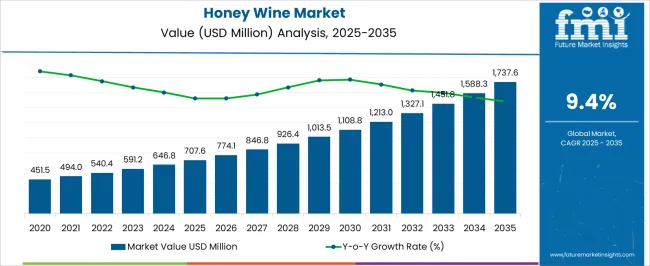
| Metric | Value |
|---|---|
| Honey Wine Market Estimated Value in (2025 E) | USD 707.6 million |
| Honey Wine Market Forecast Value in (2035 F) | USD 1737.6 million |
| Forecast CAGR (2025 to 2035) | 9.4% |
The Honey Wine market is experiencing steady growth driven by increasing consumer interest in natural and low-alcohol beverages, alongside a rising preference for products that combine health benefits with indulgence. The current market landscape reflects a demand for diversified offerings that cater to traditional tastes as well as contemporary palates, with both developed and emerging regions contributing to overall expansion.
Factors influencing growth include the rising awareness of the nutritional and antioxidant properties of honey, the resurgence of artisanal and craft beverage production, and the growing popularity of organic and clean-label products. Investment in marketing, product innovation, and distribution channels has further facilitated accessibility to consumers.
The market outlook is shaped by trends toward premiumization and flavored variants, as producers focus on enhancing quality, packaging, and experiential consumption With consumers increasingly seeking beverages that offer both cultural authenticity and modern appeal, the Honey Wine market is poised to continue its upward trajectory, providing opportunities for product differentiation and geographic expansion.
The honey wine market is segmented by nature, product type, variety, sales channel, and geographic regions. By nature, honey wine market is divided into Conventional and Organic. In terms of product type, honey wine market is classified into Sweet, Carbonated (Sparkling), Dry, Semi-Dry, and Semi-Sweet. Based on variety, honey wine market is segmented into Traditional, Cyser (Mead With Apples), Melomel (Mead With Other Fruits), Pyment (Mead With Gapes), Metheglin (Mead With Spices Or Herbs), and Others. By sales channel, honey wine market is segmented into Hotels/Restaurants/Bars, Modern Trade, Specialty Stores, Convenience Stores, Commercial, and Online Retailers. Regionally, the honey wine industry is classified into North America, Latin America, Western Europe, Eastern Europe, Balkan & Baltic Countries, Russia & Belarus, Central Asia, East Asia, South Asia & Pacific, and the Middle East & Africa.
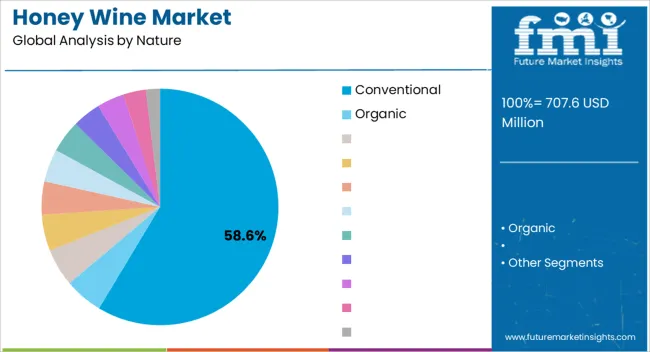
The Conventional nature segment is projected to hold 58.60% of the Honey Wine market revenue share in 2025, establishing it as the dominant type. This leadership is being driven by longstanding consumer familiarity and trust in conventional honey wines, which are perceived as reliable in quality and taste.
The growth of this segment has been supported by traditional production methods that emphasize consistency, natural fermentation processes, and flavor stability, making it suitable for large-scale commercial distribution. Investment in improving shelf life and packaging has further enhanced the appeal of conventional honey wine, particularly among retailers and distributors.
Additionally, established supply chains and recognized brand presence have reinforced market penetration, enabling wider consumer reach The combination of authenticity, consistent quality, and scalability has ensured the continued dominance of conventional honey wine, while providing a foundation for producers to introduce complementary innovations that align with evolving consumer preferences and premiumization trends.
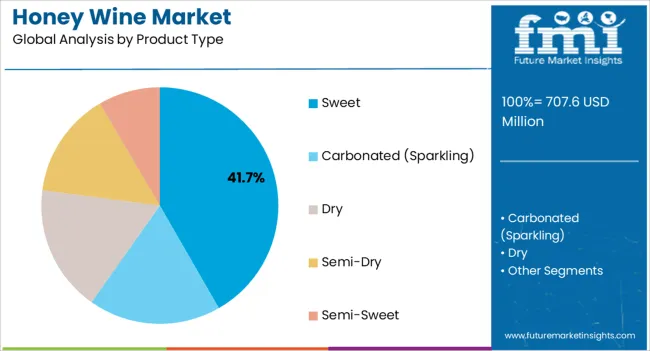
The Sweet product type segment is expected to account for 41.70% of total Honey Wine market revenue in 2025, reflecting its position as the leading product variant. This segment’s growth has been supported by consumer preference for palatable, easy-to-drink beverages that cater to both casual and festive consumption occasions.
Sweet honey wine offers a balanced sensory experience with natural honey flavors, making it appealing to a broad demographic, including first-time wine consumers and younger audiences seeking approachable alcoholic beverages. Production processes that preserve natural sweetness and enhance aroma have contributed to product differentiation, while marketing strategies highlighting taste and versatility have increased visibility.
Retail and e-commerce channels have also expanded access, enabling wider adoption The combination of sensory appeal, ease of consumption, and versatility in pairing with food or use in celebrations has positioned sweet honey wine as the dominant product type and a key driver for overall market growth.
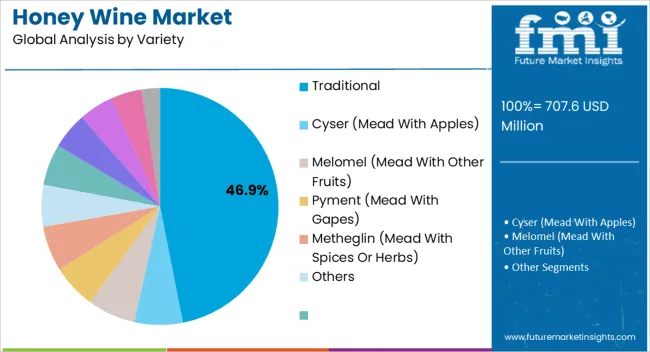
The Traditional variety segment is projected to capture 46.90% of the Honey Wine market revenue in 2025, maintaining its leading status among varieties. This segment’s growth is attributed to consumer preference for authentic formulations that reflect cultural and regional heritage, offering a classic taste profile associated with high-quality honey fermentation. Traditional honey wine production emphasizes natural ingredients, slow fermentation techniques, and minimal processing, which appeals to consumers seeking artisanal and heritage products.
The segment has benefited from the increasing interest in craft beverages and the rising popularity of heritage and authentic food and drink experiences. Availability through both specialty and mainstream channels has enhanced accessibility and expanded market reach.
Moreover, the segment supports premium pricing due to its perceived craftsmanship and authenticity, further reinforcing its market dominance As consumer interest in culturally rooted and genuine beverage experiences continues to grow, the Traditional variety is expected to sustain its leading position while guiding product development and market strategies for other honey wine variants.
Honey wine, commonly known as Mead, is an ubiquitous traditional alcoholic beverage made by fermenting honey with water, or in some cases with grains, spices, fruits, or hops. The majority of fermentable sugar of the beverage is derived from honey; this characteristic makes the honey wine stand apart from the rest of the alcoholic beverages.
The alcoholic content of honey wine ranges from 3.6% ABV to more than 19% depending upon the fermentation. The market of honey wine is anticipated to increase over the forecast year owing to factors such as rising urban population, growing inclination of adolescents and millennial towards alcoholic beverages, growing cultures of bars and lounges, and other factors which tend to drive the growth of the honey wine market.
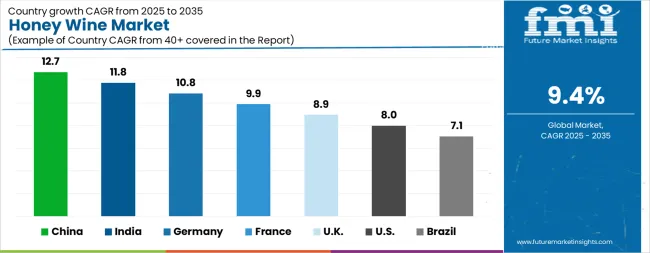
| Country | CAGR |
|---|---|
| China | 12.7% |
| India | 11.8% |
| Germany | 10.8% |
| France | 9.9% |
| UK | 8.9% |
| USA | 8.0% |
| Brazil | 7.1% |
The Honey Wine Market is expected to register a CAGR of 9.4% during the forecast period, exhibiting varied country level momentum. China leads with the highest CAGR of 12.7%, followed by India at 11.8%. Developed markets such as Germany, France, and the UK continue to expand steadily, while the USA is likely to grow at consistent rates. Brazil posts the lowest CAGR at 7.1%, yet still underscores a broadly positive trajectory for the global Honey Wine Market. In 2024, Germany held a dominant revenue in the Western Europe market and is expected to grow with a CAGR of 10.8%. The USA Honey Wine Market is estimated to be valued at USD 261.6 million in 2025 and is anticipated to reach a valuation of USD 564.2 million by 2035. Sales are projected to rise at a CAGR of 8.0% over the forecast period between 2025 and 2035. While Japan and South Korea markets are estimated to be valued at USD 34.9 million and USD 22.5 million respectively in 2025.
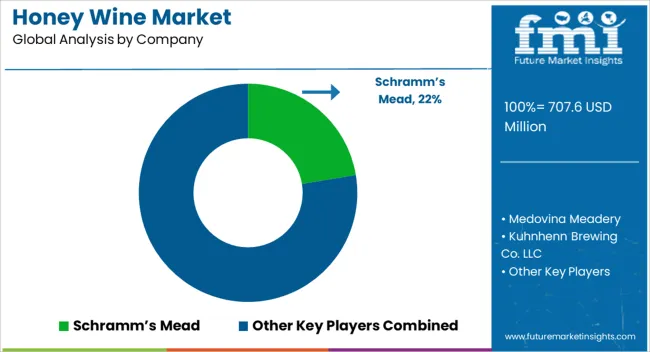
| Item | Value |
|---|---|
| Quantitative Units | USD 707.6 Million |
| Nature | Conventional and Organic |
| Product Type | Sweet, Carbonated (Sparkling), Dry, Semi-Dry, and Semi-Sweet |
| Variety | Traditional, Cyser (Mead With Apples), Melomel (Mead With Other Fruits), Pyment (Mead With Gapes), Metheglin (Mead With Spices Or Herbs), and Others |
| Sales Channel | Hotels/Restaurants/Bars, Modern Trade, Specialty Stores, Convenience Stores, Commercial, and Online Retailers |
| Regions Covered | North America, Europe, Asia-Pacific, Latin America, Middle East & Africa |
| Country Covered | United States, Canada, Germany, France, United Kingdom, China, Japan, India, Brazil, South Africa |
| Key Companies Profiled | Schramm’s Mead, Medovina Meadery, Kuhnhenn Brewing Co. LLC, Redstone, Brothers Drake Meadery, Winery Kuhnhenn Brewing Co LLC, The Honey Wine Company, Martin Brothers Winery, Moonshine Meadery, and Talon Wines |
The global honey wine market is estimated to be valued at USD 707.6 million in 2025.
The market size for the honey wine market is projected to reach USD 1,737.6 million by 2035.
The honey wine market is expected to grow at a 9.4% CAGR between 2025 and 2035.
The key product types in honey wine market are conventional and organic.
In terms of product type, sweet segment to command 41.7% share in the honey wine market in 2025.






Full Research Suite comprises of:
Market outlook & trends analysis
Interviews & case studies
Strategic recommendations
Vendor profiles & capabilities analysis
5-year forecasts
8 regions and 60+ country-level data splits
Market segment data splits
12 months of continuous data updates
DELIVERED AS:
PDF EXCEL ONLINE
Honeysuckle Market Size and Share Forecast Outlook 2025 to 2035
Honeycomb Core Materials Market Size and Share Forecast Outlook 2025 to 2035
Competitive Overview of Honeycomb Packaging Market Share
Honeycomb Packing Paper Market Analysis – Growth & Trends 2024-2034
Paper Honeycomb Market Size and Share Forecast Outlook 2025 to 2035
Dried Honey Market Size and Share Forecast Outlook 2025 to 2035
Aramid Honeycomb Core Material Market Growth – Trends & Forecast 2024-2034
Bonding Honeycomb Vibration Isolation Platform Market Size and Share Forecast Outlook 2025 to 2035
Aluminum Honeycomb Panels Market Size and Share Forecast Outlook 2025 to 2035
Wine Barrel Market Size and Share Forecast Outlook 2025 to 2035
Wine Cellar Market Size and Share Forecast Outlook 2025 to 2035
Wine Enzymes Market Analysis Size Share and Forecast Outlook 2025 to 2035
Wine Box Market Size and Share Forecast Outlook 2025 to 2035
Wine Fining Agent Market Size and Share Forecast Outlook 2025 to 2035
Wine, Scotch, and Whiskey Barrels Market Size and Share Forecast Outlook 2025 to 2035
Wine Totes Packaging Market Size and Share Forecast Outlook 2025 to 2035
Wine Fermentation Equipment Market Size and Share Forecast Outlook 2025 to 2035
Wine Processing Equipment Market Size and Share Forecast Outlook 2025 to 2035
Wine Racks Market Size and Share Forecast Outlook 2025 to 2035
Wine Filling Machine Market Size and Share Forecast Outlook 2025 to 2035

Thank you!
You will receive an email from our Business Development Manager. Please be sure to check your SPAM/JUNK folder too.
Chat With
MaRIA